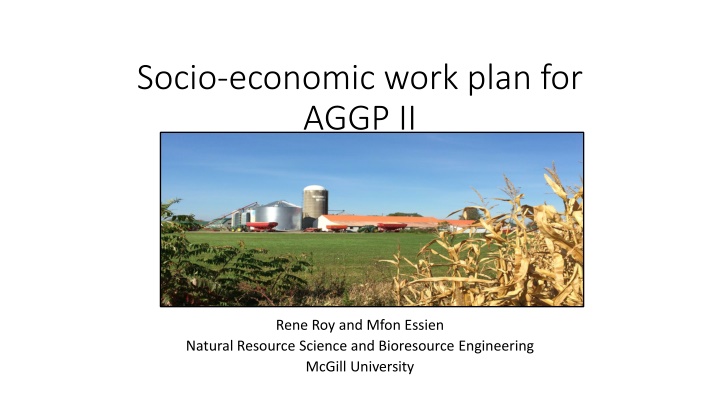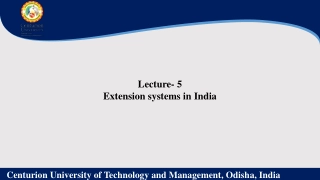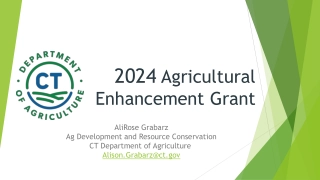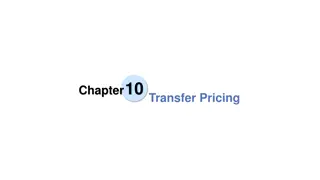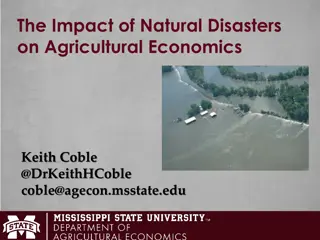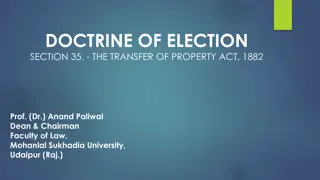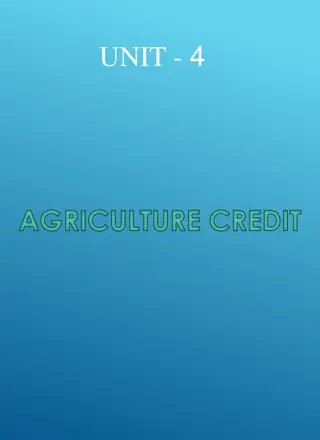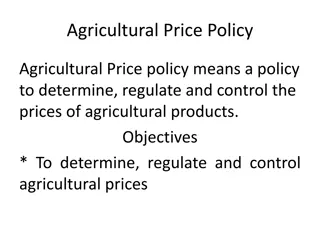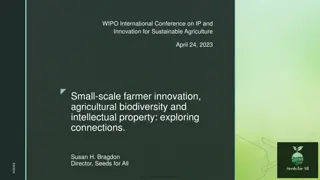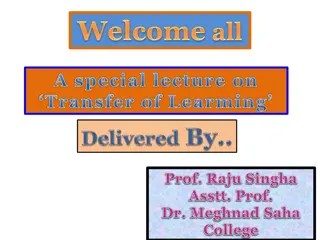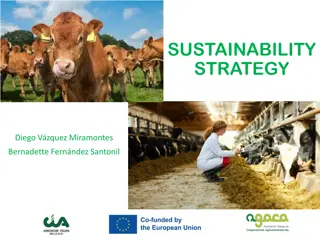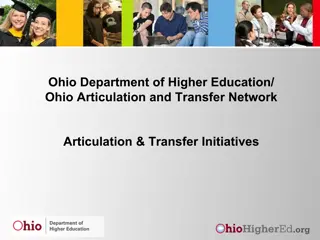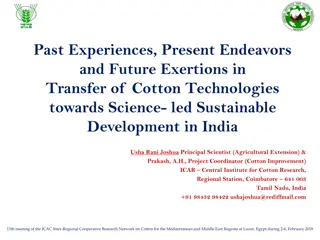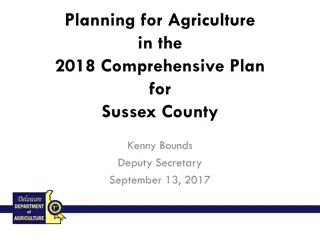Sustainable Agricultural Practices and Technology Transfer Plan
The Socio-Economic Work Plan for AGGP II focuses on the partial budgeting of beneficial management practices related to water management systems, GHG mitigation, and adaptation. It aims to identify co-benefits, assess socio-economic factors affecting water demand and climate change, develop a regional GHG emission model, and promote the implementation of BMPs among farmers through technology transfer activities. The plan includes collaborations with agricultural organizations, workshops, webinars, and surveys to facilitate the adoption of sustainable practices.
Download Presentation

Please find below an Image/Link to download the presentation.
The content on the website is provided AS IS for your information and personal use only. It may not be sold, licensed, or shared on other websites without obtaining consent from the author.If you encounter any issues during the download, it is possible that the publisher has removed the file from their server.
You are allowed to download the files provided on this website for personal or commercial use, subject to the condition that they are used lawfully. All files are the property of their respective owners.
The content on the website is provided AS IS for your information and personal use only. It may not be sold, licensed, or shared on other websites without obtaining consent from the author.
E N D
Presentation Transcript
Socio-economic work plan for AGGP II Rene Roy and Mfon Essien Natural Resource Science and Bioresource Engineering McGill University
Outline Socio-economic Objectives (AGGP II - the big picture) Technology transfer activities Socio-economic studies Methodology Data needs Expected timeline: Work plan 2017/2018
Socio-Economic Objective AGGP II Partial budgeting of Beneficial management practices (BMPs) of water management systems related GHG mitigation and adaptation practices. Identify and estimate the potential co-benefits of the BMPs Assessment of Socio-economic factors influencing water demand and climate change. Development of a regional GHG emission model Encourage implementation of BMPs by farmers (technology transfer) To inform decision makers of policy instruments or mechanism that would encourage adoption of BMPs
Technology transfer To help the agronomists disseminating the information: We will collaborate with the Centre de R f rence en Agriculture et Agroalimentaire du Qu bec (CRAAQ) to publish partial budget of the BMPs (Availability by the end of 2018) We will present workshop to professional groups and extension personel involved in farm consulting (R seau Agri-conseil, Ordre des agronomes). (First seminar before the end of 2017) We will collaborate with a progressist regional consultants to accelerate the dissemination of the BMP information to producers and better understand the BMP adoption (The collaboration will be prepared in 2017 and undertaken in 2018-2019)
Technology transfer To help producers adopting BMPs We will approach Farm Management Canada to organize webinars about BMPs for Canadian producers (Webinar in Winter 2018) We will hold workshops in collaboration with the Producteurs de Grain du Qu bec. (annual meetings: 2017, 2018, 2019, 2020) We will publish documents on specialized websites such as Agri-R seau and AAFC about how to implement the BMPs (One documents issued every year: 2017, 2018, 2019, 2020) We will hold focus groups with producers and survey them to get information about the factors influencing the adoption of BMPs. (The coordination of this activity will be in conjunction with the researchers involved, and will be completed by the end of 2020)
Social Benefit of Beneficial Management Practice Total Economic Value Indirect use Direct use Non-extractive use Environmental services Non-use value Option value Extractive use Existence value Bequest value The value that next generation could benefit from the use of the good - The possibility of using the good in the future - Recreative activities - Landscape amenities - Greenhouse Gas control - Nutrient cycling - Water cycling - Tap water - Fishing - Agriculture The intrinsic value of the good
Implementing Best Water Management Practices in Agriculture Other Hydric impact Economic Impact environmental impact (Aesthetic, biodiversity, etc.) Social Benefit-cost analysis Atmospheric impact Social Benefits - Private Benefit- cost analysis BMPs Private Cost Hydric pollutant emission = Net benefit of BMPs implementation Value of goods and services from atmospheric services Water Quality Index Value of goods and services from aesthetic and biodiversity services Benefit transfer function Value of goods and services from hydric services
Why the need for research? To efficiently undertake an integrated Bio-economic modelling of water management BMPs geared towards GHG mitigation and adaptation, that are adoptable by farmers and effectively communicate these BMPs to producers.
Objectives To assess farm level profitability using a whole farm analysis and environmental evaluation from adoption of beneficial water management practices using LCA Using a Decision Support System for Agricultural Technology (DSSAT) model to assess BMP potential in terms of profitability and impact on environment over time by calculating co-benefits from reduced GHG emissions, carbon sequestration, improved yield and water quality Assess farmers perception and determinants of adoption of BMPs Using a Multi-criteria analysis to conduct rigorous policy appraisal from the policy options given by the economic outcomes
Methodology Whole Farm Budget analysis Bio-Economic modelling Life cycle Analysis (LCA): to estimate farm-level environmental and economic impact of installing water management system Decision Support System for Agrotechnology Transfer (DSSAT): This modelling approach connects the bio-physical and socio-economic variables within a unified and coherent framework to produce a global assessment of crop production under climate change. Regression or qualitative analysis: to assess the factors affecting farmers adoption of BMPs (Specifically, water management practices)
Methodology Multi-Criteria Analysis (MCA): develop a decision making framework, which enables rigorous policy appraisals based on economic outcome of the BMPs towards mitigation of GHG emissions in a cost effective and sustainable manner, both at the farm and regional level. It will take three larger criteria in consideration i.e. economic, environmental and social with a ranking of the best alternative based on a weighting system. A sensitivity analysis would be employed to test the robustness of results.
Data needs Site Physical characteristics and information: Location Farm size Soil type Topography Seed variety Planting date and Harvest date. Annual tillage practices 2017 2020 Monthly precipitation and temperature data each year (2017 2020) Historical and forecasted precipitation and temperature data (Environment Canada) Lime application (kg/hectare) 2017 2020 Type of herbicide used and application rate (Kg/hectare) 2017 - 2020
Data needs Years Water system (AGGP study) Water system BMP (AGGP Study) Fertilizer Data Inorganic Organic Inorganic Organic Year 1:2017 Year 2:2018 Year 3:2019 Year 4:2020 Fertilizer data (kilogram/hectare): type, timing and quantity E.g. NPK - Inorganic fertilizer, Cattle manure Organic fertilizer
Data needs Years Preexisting condition or status quo e.g. if not FD. Data from region i.e. CRAAQ Water system Water system BMP Year 1:2017 Year 2:2018 Year 3:2019 Year 4:2020 Yield Data (Tonnes/hectare): i.e. yield data from each field site for Leamington, Sherrington, Harrow and St. Emmanuel for tomatoes, onion and corn and/or soybean respectively for each crop. E.g. the table above is for Corn production with inorganic fertilizer in St. Emmanuel, there should be a replicate for organic fertilizer FD: Field Drainage CDSI: Controlled drainage with Sub-irrigation
Data needs Years Water system Water system BMP Gas data N20 CO2 CS N2O CO2 CS Year 1:2017 Year 2:2018 Year 3:2019 Year 4:2020 GHG emissions data (e.g. N20/Hectare): N20, CO2 i.e. atmospheric or carbon sequestration data from each Water management treatment, under different crops (in each site) and fertilizer treatment i.e. for inorganic and organic fertilizer or soil types depending on the specific site. CS= Carbon Sequestration
Data needs Years Water system Water system BMP Water data Water quality Quantity of water irrigated or applied Water quality Year 1:2017 Year 2:2018 Year 3:2019 Year 4:2020 Water Data: Water quality assessing quantity of nitrates and phosphorus in the water.
Expected timeline Time Activity Remarks January December, 2017 Socio-economic data collection and building farm budget In progress January December, 2017 Socio-economic model development of LCA and DSSAT In progress April- October, 2017 Annual Socio-economic data collection: Farm and Regional Level June- August, 2017 Data collection to obtain information for farmers workshops In progress January March, 2018 Dissertation proposal
Thank you Questions
